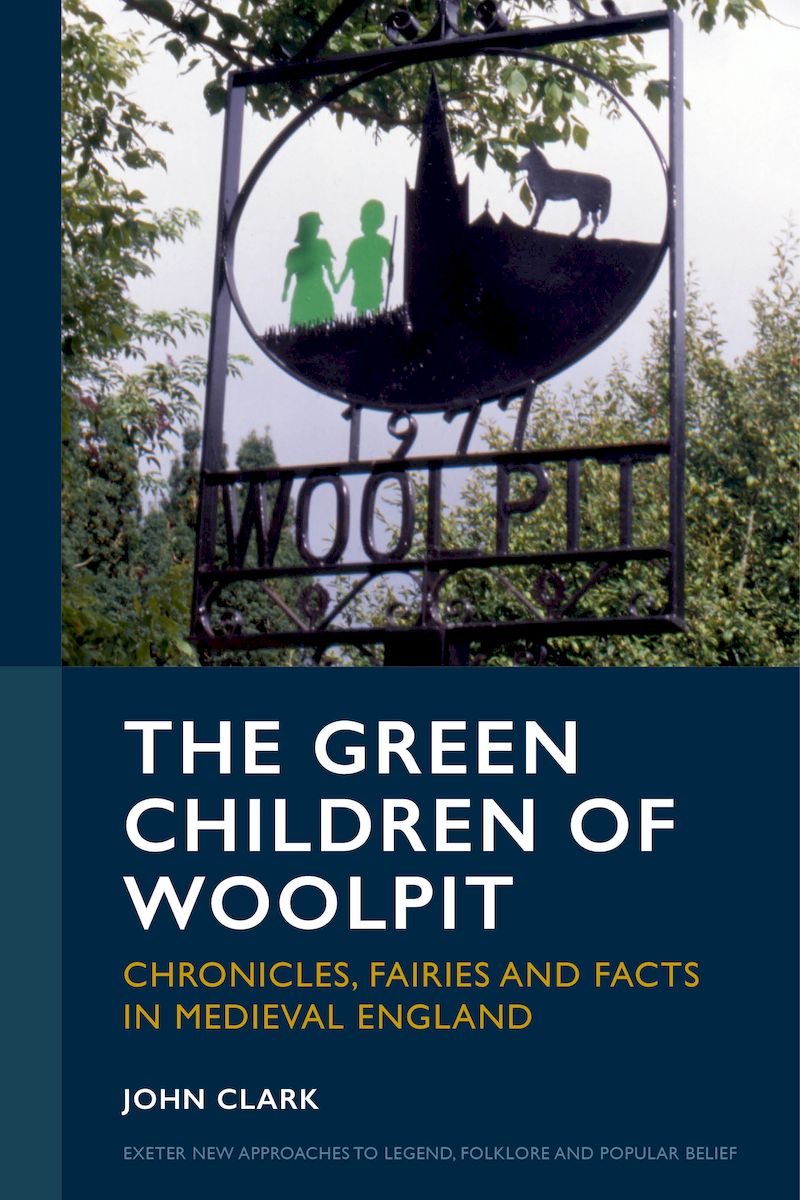University of Exeter Press
The Green Children of Woolpit
Chronicles, Fairies and Facts in Medieval England
Couldn't load pickup availability

- 274 Pages
Shortlisted by The Folklore Society for The Katharine Briggs Award 2025.
Two medieval chroniclers, William of Newburgh and Ralph of Coggeshall, reported the mysterious appearance of a pair of ‘Green Children’—with green skins and speaking an unknown language—in the Suffolk village of Woolpit in the mid-twelfth century. The story is well known today, usually as a Suffolk folktale about fairies and a fairy otherworld. Retold many times, it continues to inspire novels, poetry, songs, plays, and even operas.
This book analyses the story in its historical and geographical context, and considers the numerous ways in which it has been interpreted, recounted, and reimagined by historians, folklorists, philosophers, and writers. Folklorists have mined it for ‘folktale motifs’ without considering whether it is truly a folktale. Historians have used it as a key to understanding the motives of one or other of the two chroniclers who recorded it. ‘Fortean’ researchers have tried to find a convoluted core of historical fact.
Returning to the two original Latin accounts, this book translates them afresh and analyses them side by side for the first time, allowing us to conclude that both writers were drawing on the same source. Such an interdisciplinary study is necessary when considering the many modern ‘explanations’ of the events that have been offered, from mundane to extraterrestrial. The volume presents an example of how extraordinary events reported by medieval chroniclers can be studied analytically, and will interest not only medievalists but anyone interested in folklore and fairylore—and perhaps inspire others to fresh reworkings of this perpetually intriguing story.
A magisterial, authoritative and, above all, sensibly judicious account of the Green Children of Woolpit, this book moves deftly between the medieval and the modern, sources and reception. It unpacks the multiple possibilities for the interpretation of the tale in its contexts and lays a solid foundation for future engagement with this unparalleled and mysterious story.
Carolyne Larrington, Emerita Professor of medieval European literature, University of Oxford
What is so outstanding about this enquiry is its demonstration of the power of story. Thorough, fair-minded and genuinely wise, John Clark's detective work shows just how and why the mysterious folk-legend of the green children has attracted and inspired such wide attention, including that from folklorists, rationalisers and artists. I've learned a very great deal from it, and once again fallen under the spell of this story, so strange and yet somehow so familiar, of these 'two little twelfth-century waifs' of Woolpit.
Kevin Crossley-Holland, author and poet
An outstandingly detailed, perceptive and wide-ranging study of an endlessly fascinating tale that will become the authoritative study of the subject, and is also compellingly readable.
Francis Young, Historian, Suffolk folklorist, and author of Twilight of the Godlings
This is an admirably thoughtful, wide-ranging and persuasive consideration - the best yet - of one of England's most famous medieval legends.
Ronald Hutton, Professor of History, University of Bristol
[John Clark] gathers up the dust of centuries, tosses theories on the scales, adds appropriate filters, and, in a worthily nit-picking feat of all-round scholarship, rounds out the context for these mystery children and their subsequent fate in a way that no prior researcher has done. The text is as interesting for its intense questioning of elements as for the fascinating story itself.
John Billingsley
Northern Earth
The Green Children of Woolpit is a comprehensive, meticulously referenced and fascinating delve into this most-beguiling of stories, for which John Clark should be highly commended. Crucially, it's also very readable.
Edward Parnell
Fortean Times
This is an extensively researched and referenced study... It is a fascinating, and despite its deep scholarship, an accessible account of how stories and legends develop and are interpreted and exploited through antiquarian studies and modern re-workings.
John Rimmer
Magonia
Above all, we are confronted with the power of a well-told story. That’s what William and Ralph did in the 12th century—and what Clark does for his readers in the 21st. I recommend this book not only as an example of rigorous research—worthy of the most diligent scholar or the most obsessive detective—but also as a way to keep the story—and above all, the mystery—alive.
Adriana Guillén Ortiz
Boletín de Literatura Oral
...no one has ever known more about the Green Children than [John Clark]... The Green Children of Woolpit is a synthesis of history (academic and popular) with folklore, Fortean studies, and science fiction. There is nothing that Clark has not read in his search for the cultural reception of this story...
Jeremy Harte
Folklore
Clark applies methodical precision to his material: he analyzes every claim and counterclaim. But despite the density of his research, his prose retains a lightness and ease that makes the book a hugely enjoyable read, ensuring its accessibility to a wide readership. While the story of the green children receives a forensic handling, Clark’s enjoyment of it, in all its metamorphic complexity, shines through.
Sonia Overall
Preternature
The Green Children of Woolpit is a fascinating and well-researched piece of scholarship that will be of interest to a wide range of readers... Clark’s interdisciplinary background seems crucial to his nuanced analysis of the tale in its historical, cultural, linguistic, and geographical context. Moreover, the book proves interesting as much for Clark’s examination of previous analyses of the legend as it does for his exploration of the Green Children’s story.
Maija Birenbaum
Supernatural Studies
The level of detail is impressive and there is no doubting the significant effort involved in assembling the information presented here.Stephen De Hailes
The Medieval Review
List of illustrations
Acknowledgements
1. An Introduction
2. The Story and its Legacy
3. Transmission
4. Interpretations
5. The Chroniclers and the Texts
6. The Framing Narrative
7. The Children’s Story
8. Excursions
9. Strangers in a Strange Land
Appendix: The Sources
William of Newburgh
Ralph of Coggeshall
Notes
Bibliography
Retellings, Reworkings and Reimaginings: A Chronological Listing
Index
- 274 Pages














